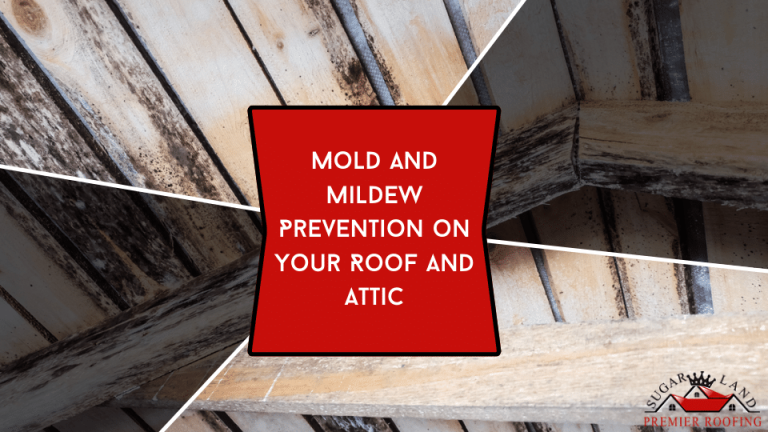Mold and Mildew Prevention on Your Roof and Attic with Sugar Land Premier Roofing. When it comes to maintaining your home’s health and longevity, keeping your roof and attic free from mold and mildew is a top priority. These unsightly and potentially harmful growths not only affect the appearance of your home but can also lead to structural damage and health issues if left unchecked. In this article, we’ll explore the causes of mold and mildew on roofs and in attics, the potential consequences, and effective prevention and remediation strategies.

Causes of Mold and Mildew on Roofs and in Attics:
Moisture: The primary cause of mold and mildew growth in attics and on roofs is excessive moisture. Moisture can seep in through damaged roofing materials, poor ventilation, or leaks. It creates an ideal environment for mold and mildew to thrive.
Poor Ventilation: Inadequate attic ventilation traps moisture and warm air, creating conditions conducive to mold and mildew growth. Proper ventilation is essential to regulate temperature and humidity.
Leaky Roof: Roof leaks, whether due to damaged shingles, flashing, or aging roofing materials, introduce water into the attic. This moisture can saturate insulation and structural components, promoting mold growth.
Condensation: Condensation can occur in attics when warm, humid air meets cooler surfaces, such as the underside of the roof deck. This condensation provides the moisture needed for mold and mildew development.
Debris Accumulation: Leaves, branches, and other debris can accumulate on roofs and in gutters, leading to water retention and clogged drainage. This debris can hold moisture and contribute to mold growth.
Consequences of Mold and Mildew Growth:
Structural Damage: Mold and mildew can compromise the structural integrity of your home by weakening wood, sheathing, and roofing materials. Prolonged exposure to moisture can lead to rot and decay.
Health Risks: Mold spores can become airborne and pose health risks to occupants, particularly those with respiratory conditions or allergies. Exposure to mold can cause respiratory problems, skin irritation, and allergic reactions.
Reduced Energy Efficiency: Mold-infested insulation loses its insulating properties, reducing your home’s energy efficiency and increasing heating and cooling costs.
Odor and Aesthetic Issues: Mold and mildew growth can produce musty odors and unsightly stains on your ceilings and walls. This can affect your home’s indoor air quality and aesthetic appeal.
Prevention and Remediation Strategies:
Regular Roof Inspections: Schedule annual roof inspections to detect and address any damage or potential sources of leaks promptly. Addressing minor issues early can prevent major problems later.
Proper Ventilation: Ensure your attic has adequate ventilation. Proper ventilation helps regulate temperature and humidity, reducing the risk of condensation and mold growth. Install ridge and soffit vents to promote airflow.
Roof and Gutter Maintenance: Keep your roof and gutters clean and free of debris. Regularly remove leaves, branches, and other materials that can trap moisture and obstruct drainage.
Address Leaks Promptly: If you notice signs of a roof leak, such as water stains or wet insulation in the attic, address the issue immediately. Repair or replace damaged roofing materials and address the source of the leak.
Insulate and Seal: Properly insulate your attic and seal any gaps or cracks to prevent warm, humid air from entering. Use vapor barriers to reduce moisture infiltration.
Install Exhaust Fans: Consider installing exhaust fans in bathrooms and kitchens to vent warm, humid air directly outside rather than into the attic. This helps reduce humidity levels in the attic.
Use Mold-Resistant Materials: When replacing roofing materials or insulation, opt for mold-resistant products. These materials are designed to deter mold and mildew growth.
Regular Cleaning: Periodically clean and inspect your attic for signs of mold or mildew. If you discover any growth, address it promptly to prevent it from spreading.
Professional Remediation: If mold growth is extensive or if you have health concerns, consult a professional mold remediation specialist. They have the expertise and equipment to safely remove mold and prevent its return.
Monitor Indoor Humidity: Keep an eye on indoor humidity levels. Use a dehumidifier if necessary to maintain a comfortable and mold-unfriendly environment.
Conclusion:
Mold and mildew prevention and remediation on your roof and in your attic are crucial for the overall health and longevity of your home. By addressing moisture sources, improving ventilation, and conducting regular inspections and maintenance, you can create an environment that discourages mold and mildew growth. If you suspect mold or mildew issues, consult with professionals who can assess the situation, provide remediation services, and help you maintain a safe and healthy living space. Taking proactive steps to prevent and address mold and mildew can protect your home, your family’s health, and your investment in your property.
For more information, contact Sugar Land Premier Roofing at 832-639-1299. We service areas in Sugar Land, Katy, Deer Park, and Houston, TX.

